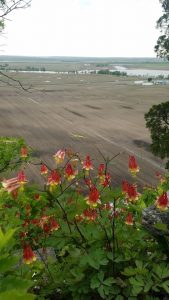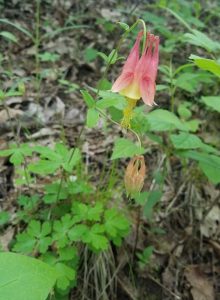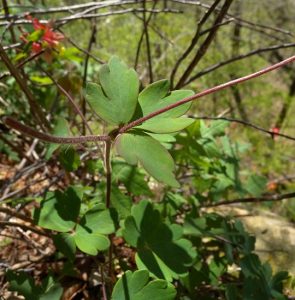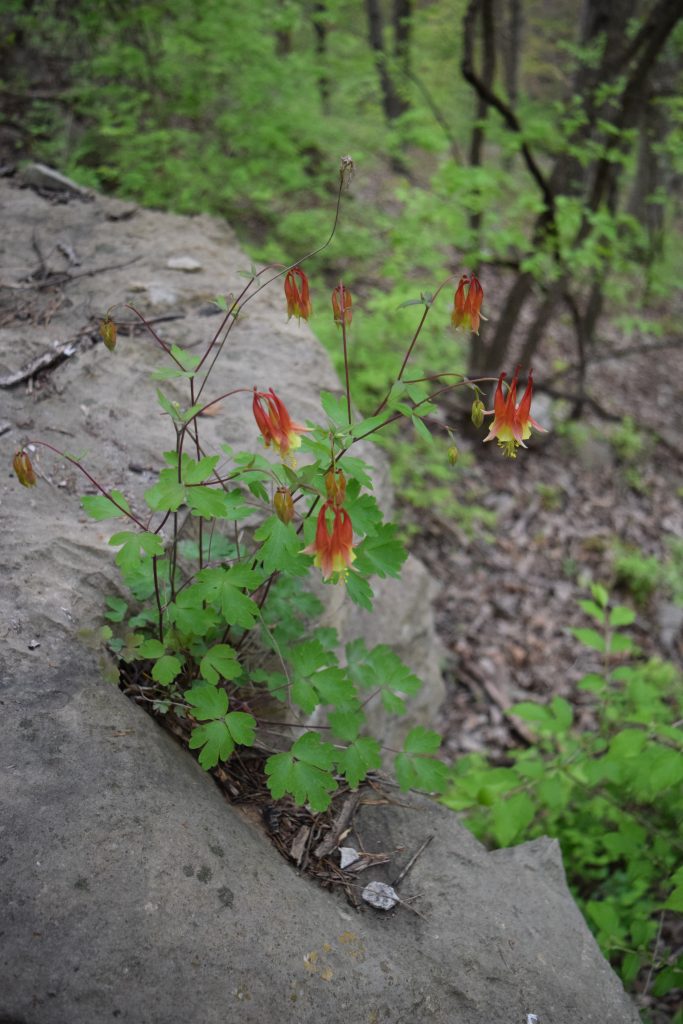Columbines Dazzle Where Other Wildflowers Fear to Tread

One of the most underrated of Illinois’ native wildflowers, wild columbine (Aquilegia canadensis), grows where other flora fear to tread—at the edges of cliffs and out of limestone boulders. Columbine is not showy like other spring bloomers such as Virginia bluebell and Celandine poppy. Columbines are unassuming in their beauty with their nodding blossoms of red tipped with yellow and bring back memories of childhood playing among grandma’s flower gardens.
The U. S. Forest Service tells us that the genus Aquilegia arrived in North America 10,000 to 40,000 years ago during the Pleistocene age. The Bering land bridge provided a connection between northeastern Asia and unglaciated parts of Alaska and the Yukon. This land connection allowed many plants and animals to spread between the Asian and American continents. It is believed that columbines crossed into North America from Asia via this land bridge at that time.

As a noun, the word columbine comes from Latin columbina herba meaning dove-like plant, the flower being likened to five clustered pigeons. The blossom symbolizes wisdom, strength and happiness. Illinoiswildflowers.info describes each flower as being about 1 ½ inches long as it hangs downward from a long stalk. The flower has five petals, 5 petal-like sepals and strongly exerted stamens and styles. Each petal is yellow and rounded toward the tip, but its base consists of a long nectar spur that is pale red to purplish red. Each leaflet is divided into 3 rounded lobes.

Red color and increased sugar content in the nectar were adaptations undergone by Aquilegia to North American ecosystems of flowers pollinated by hummingbirds. Increased sugar content in the nectar evolved to satisfy the higher energy needs of hummingbirds compared to other columbine pollinators such as hawk moths, bees and bumblebees. Aquilegia canadensis is the only columbine east of the 100th meridian (which runs through the middle of Texas, Oklahoma, Kansas, Nebraska and North and South Dakota) and found throughout the entire range of the ruby-throated hummingbird. It is the only columbine native to Illinois and can be found in Monroe, Randolph and St. Clair counties in rocky open woodlands, wooded slopes, thinly wooded bluffs, partially shaded areas of cliffs and limestone glades.

The larvae of various insects feed on Wild Columbine, including those of Columbine Duskywing, Borer Moth, Columbine Sawfly and several Leaf Miner Flies. Because the foliage is toxic, columbine is rarely bothered by mammalian herbivores, which makes it perfect for a garden frequently visited by deer. Once it becomes established, the columbine is easy to maintain.
CLIFFTOP, a local nonprofit organization, is focused on preserving and protecting area bluff lands.
A version of this article appeared in the May 15, 2020 edition of the Monroe County Independent.
©2020 all content rights reserved Clifftop NFP
Comments are currently closed.
